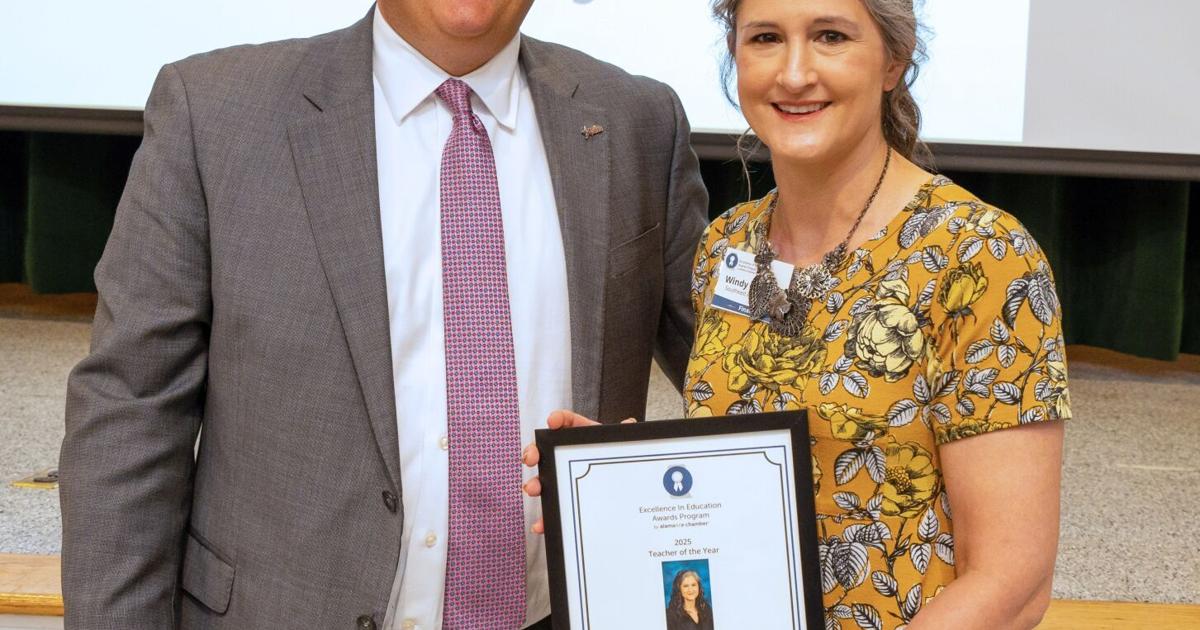
Although Windy Lampson is now Alamance-Burlington School System’s 2025 Teacher of the Year, she did not begin an education career after finishing college.
Lampson, now visual arts teacher at Southeast Alamance High School, obtained a master’s degree from East Carolina University’s School of Art & Design and began working as a professional painter upon graduation.
Her first foray into the field of education was serving as an art teacher at an elementary school, and it wasn’t a fit.
“I didn’t really love [teaching] elementary school because you see the students for like once, maybe 40 minutes every week, and you see everybody in the school,” Lampson said. “Where I’m at now, I can see the same students 90 minutes a day, every day, and I get to build relationships with them and get to know them and really, actually have a meaningful impact in their lives.”
Lampson joined the faculty of Graham High School in 2009, and she admits it took some time to adapt her teaching style to instructing 15- to 18-year-olds.
“I found management of high schoolers very difficult at first, but about three years in, I started to find that groove,” Lampson said.
Lampson, a veteran teacher with 14 years of experience, was one of eight finalists for Teacher of the Year at the May 6 awards ceremony sponsored annually by the Alamance Chamber. Lampson said she was grateful to be a finalist and was caught off-guard when her name was called.
“I was just prepared to be happy, regardless,” Lampson told the Times-News. “I definitely didn’t expect to win. The other finalists in the category — I’ve heard amazing things about them. I didn’t prepare a speech because I was afraid if I prepared a speech, I might get disappointed, … and then I was surprised when they said my name.”
According to a 2024 study by the North Carolina Arts Education Leadership Coalition, the total number of public school students enrolled in at least one arts class tops 1.1 million. However, the same study reveals a precipitous drop in arts course enrollment based on grade levels — 74% of middle schoolers in North Carolina are enrolled in at least one arts class, while that number drops to 37% for high schoolers.
Lampson said investments by school districts to ensure that arts education is available to all students at all grade levels is a wise investment in the future.
“Arts education gets kids to school,” Lampson said. “The arts and athletics — kids really enjoy that they’re developing skills in those areas. It’s one of the things that kids look forward to going to school for so short-term. It gets them involved.”
Lampson said the most important life skills she teaches are critical thinking skills that will benefit all students regardless of the vocation they choose after high school.
“Visual art makes students critical thinkers,” Lampson said. “I focus a lot on on choice and thinking about the decisions we make, because we make choices all day long without thinking of the fact that we’re making a choice.”
Lampson cited as an example having her students sketch a portrait to reveal how a fundamental understanding of creative choices and the impact of those choices resonates with her students.
“If you’re drawing a portrait and you just put the face right in the middle, that’s a choice that you just made. … They’ll just draw something, they’ll put it right in the middle of the paper because they don’t realize that that’s a choice that they have,” Lampson said. “And what if we did it here? Or if we cropped it? If you make these other choices, what does that mean, and what does that tell your viewer, and how does it make them feel, and what emotions can be brought from that?”
Lampson said the foundation of her visual arts and pottery classes is tapping into each student’s inherent creativity, and helping them break free of preconceived notions, or personal schemas.
“My students want to know, ‘OK, how do I draw this person? What do I do first?’” Lampson said. “I try to teach them, that’s a schema, and that’s what you think drawing is right now, you think it’s a series of steps that I need to teach you, but you need to discover the steps yourself, and they they’re not all the same steps that I follow, and they’re going to be different steps, and you might purposely change a step, and think of if you have to know why you’re following those steps to know why you might want to change one of them.”
Lampson firmly believes that same level of creative thinking greatly benefits her students in their math and science courses. Lampson also believes in taking a creative approach to her pedagogy. For example, Lampson uses ever-changing seating assignments in her classroom to break down social barriers and build camaraderie among her students.
“They know every single Monday that there’s a sign on my window, and they walk in the door and it says what table they’re at,” Lampson said. “So they have choice within that table, but they’re at that table.”
Lampson said her students were not thrilled with being assigned a random table every week, but eventually, she began to see the dividends.
“It prevents little cliques from forming in the class where you have like a group of kids, and even though everybody’s behaving and they’re doing their work, we’re all listening to … [the same students] talk the whole class period,” Lampson said. “I explain to them, ‘I want people to see what you’re working on, even if you don’t talk to each other,’ and they’re saying, ‘Oh, wow. I didn’t know you could do that.’ It sounds like a really simple thing, but mixing the seats up every Monday has been a huge thing.”
